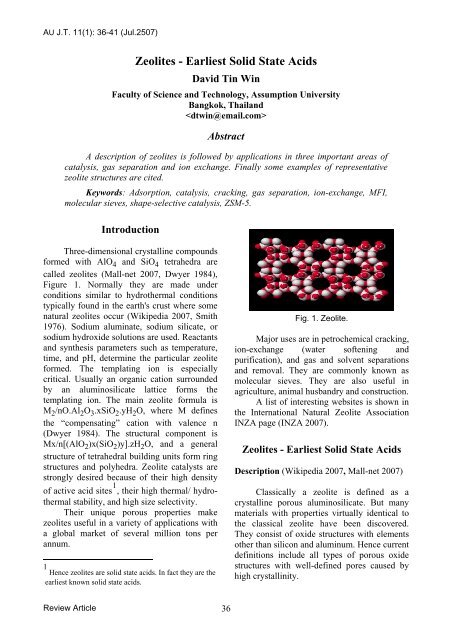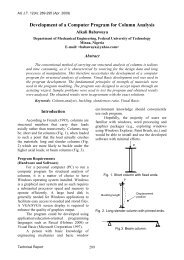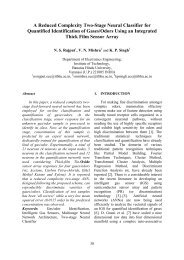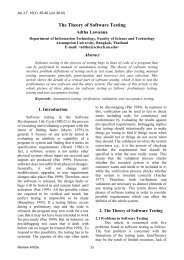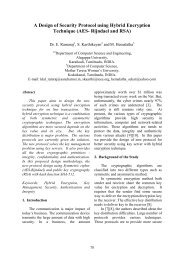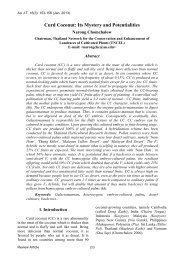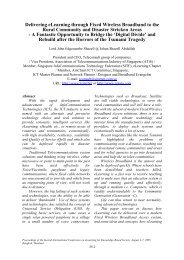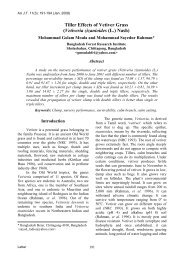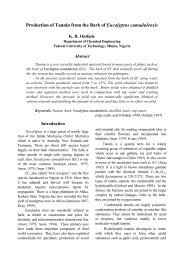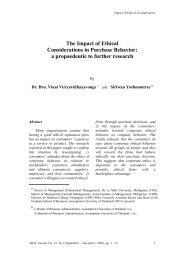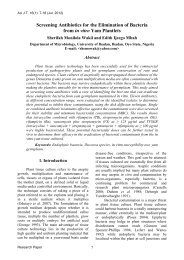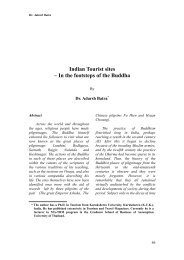Zeolites - Earliest Solid State Acids - AU Journal
Zeolites - Earliest Solid State Acids - AU Journal
Zeolites - Earliest Solid State Acids - AU Journal
Create successful ePaper yourself
Turn your PDF publications into a flip-book with our unique Google optimized e-Paper software.
<strong>AU</strong> J.T. 11(1): 36-41 (Jul.2507)<br />
<strong>Zeolites</strong> - <strong>Earliest</strong> <strong>Solid</strong> <strong>State</strong> <strong>Acids</strong><br />
David Tin Win<br />
Faculty of Science and Technology, Assumption University<br />
Bangkok, Thailand<br />
<br />
Abstract<br />
A description of zeolites is followed by applications in three important areas of<br />
catalysis, gas separation and ion exchange. Finally some examples of representative<br />
zeolite structures are cited.<br />
Keywords: Adsorption, catalysis, cracking, gas separation, ion-exchange, MFI,<br />
molecular sieves, shape-selective catalysis, ZSM-5.<br />
Introduction<br />
Three-dimensional crystalline compounds<br />
formed with AlO 4 and SiO 4 tetrahedra are<br />
called zeolites (Mall-net 2007, Dwyer 1984),<br />
Figure 1. Normally they are made under<br />
conditions similar to hydrothermal conditions<br />
typically found in the earth's crust where some<br />
natural zeolites occur (Wikipedia 2007, Smith<br />
1976). Sodium aluminate, sodium silicate, or<br />
sodium hydroxide solutions are used. Reactants<br />
and synthesis parameters such as temperature,<br />
time, and pH, determine the particular zeolite<br />
formed. The templating ion is especially<br />
critical. Usually an organic cation surrounded<br />
by an aluminosilicate lattice forms the<br />
templating ion. The main zeolite formula is<br />
M 2 /nO.Al 2 O 3 .xSiO 2 .yH 2 O, where M defines<br />
the “compensating” cation with valence n<br />
(Dwyer 1984). The structural component is<br />
Mx/n[(AlO 2 )x(SiO 2 )y].zH 2 O, and a general<br />
structure of tetrahedral building units form ring<br />
structures and polyhedra. Zeolite catalysts are<br />
strongly desired because of their high density<br />
of active acid sites 1 , their high thermal/ hydrothermal<br />
stability, and high size selectivity.<br />
Their unique porous properties make<br />
zeolites useful in a variety of applications with<br />
a global market of several million tons per<br />
annum.<br />
1 Hence zeolites are solid state acids. In fact they are the<br />
earliest known solid state acids.<br />
Fig. 1. Zeolite.<br />
Major uses are in petrochemical cracking,<br />
ion-exchange (water softening and<br />
purification), and gas and solvent separations<br />
and removal. They are commonly known as<br />
molecular sieves. They are also useful in<br />
agriculture, animal husbandry and construction.<br />
A list of interesting websites is shown in<br />
the International Natural Zeolite Association<br />
INZA page (INZA 2007).<br />
<strong>Zeolites</strong> - <strong>Earliest</strong> <strong>Solid</strong> <strong>State</strong> <strong>Acids</strong><br />
Description (Wikipedia 2007, Mall-net 2007)<br />
Classically a zeolite is defined as a<br />
crystalline porous aluminosilicate. But many<br />
materials with properties virtually identical to<br />
the classical zeolite have been discovered.<br />
They consist of oxide structures with elements<br />
other than silicon and aluminum. Hence current<br />
definitions include all types of porous oxide<br />
structures with well-defined pores caused by<br />
high crystallinity.<br />
Review Article 36
<strong>AU</strong> J.T. 11(1): 36-41 (Jul.2507)<br />
In classical zeolites the silicon or<br />
aluminum atoms are surrounded by four<br />
oxygen anions forming an approximate<br />
tetrahedron. The apex tetrahedral metals are<br />
called T-atoms. These tetrahedra stack in<br />
regular arrays and form channels. Stacking<br />
possibilities are virtually limitless giving<br />
hundreds of unique structures.<br />
The zeolitic channels (or pores) are<br />
microscopically small (molecular size<br />
dimensions) and are therefore called<br />
"molecular sieves". The size and shape of the<br />
channels influence the adsorption properties of<br />
these materials making them useful in<br />
separation processes. Molecules can be<br />
separated via shape and size effects related to<br />
their possible orientation in the pore, or by<br />
differences in adsorption strength.<br />
Silicon is typically in a 4+ oxidation state<br />
and the silicon-oxygen tetrahedra are<br />
electrically neutral. But aluminum in zeolites<br />
exists in the 3+ oxidation state, making anionic<br />
zeolite frameworks. To maintain electrical<br />
neutrality cations populate the pores. These<br />
“compensating” cations participate in ionexchange<br />
processes, and give some important<br />
properties to zeolites. "Soft" cations such as<br />
sodium make zeolites excellent water softeners<br />
because they can replace the "hard" magnesium<br />
and calcium cations in water. If protons are the<br />
compensating cations, the zeolite becomes a<br />
strong solid acid. Such solid acids are the basis<br />
of zeolite catalysis, including the fluidized-bed<br />
cat-cracking refinery process. Other metal<br />
cations can also populate the pores giving<br />
unique catalytic materials. Thus zeolites are<br />
also used in "shape-selective catalysis".<br />
The nature of acid sites in zeolites and<br />
the factors that influence enhanced catalytic<br />
activity have been of much interest. Whether<br />
all of acid sites are homogeneous or<br />
heterogeneous in acid strength requires<br />
quantifying the acidity. In this context, density<br />
functional theory (DFT) becomes crucial. For<br />
example, investigation of the reactivity of the<br />
acid sites in the zeolite chabazite (SSZ-13)<br />
revealed that the proton affinities of the four<br />
acidic oxygens at the aluminum T-site are all<br />
roughly the same. The deprotonation energy is<br />
not connected to the O-H bond length or the<br />
vibrational stretch frequency. The strength of<br />
the acid sites in chabazite is not influenced<br />
significantly by chemical or structural<br />
variations in the framework near the acid site.<br />
Applications<br />
A wide variety of industrial applications<br />
of zeolites, mainly catalysis and separations,<br />
exist. Development of the methanol to gasoline<br />
(MTG) process by Mobil in the 1970's<br />
(increased gasoline yield from each barrel of<br />
crude oil by 50 percent and improved octane<br />
number) (ExxonMobil 2007) and development<br />
of methanol to olefins (MTO) process by<br />
UOP/Hydro in 1996 (UOP/Hydro 2007)<br />
spurred petrochemical zeolite applications.<br />
Heterogeneous catalysts have an edge over<br />
liquid-phase processes. Waste minimization,<br />
wide range of possible process operating<br />
conditions, and ease of product separation are<br />
some advantages.<br />
However, solid-acid catalysts cannot<br />
replace all industrial homogeneous catalysts.<br />
Difficulties in reactant and product diffusion to<br />
and from the zeolite surface in the absence of a<br />
solvent are a major obstacle.<br />
There are three main zeolites industrial<br />
applications: catalysis, gas separation and ion<br />
exchange (Lentech 2007). A more detailed<br />
description is available elsewhere (Wikipedia<br />
2007).<br />
Catalysis (Lentech 2007): This is the<br />
most important application. Several important<br />
organic reactions are catalyzed by zeolites. The<br />
most important are cracking, isomerisation and<br />
hydrocarbon synthesis. A diverse range of<br />
catalytic reactions including acid-base and<br />
metal induced reactions can be promoted by<br />
zeolites. The reactions occur within the zeolite<br />
pores and allow greater product control.<br />
Hydrogen-exchanged zeolites, whose<br />
framework-bound protons yield very high<br />
acidity, form an important class of catalysts.<br />
Many organic reactions, including crude oil<br />
cracking, isomerisation and fuel synthesis use<br />
this type of zeolite catalyst. <strong>Zeolites</strong> can also<br />
catalyze oxidation or reduction, often after<br />
metals have been introduced into the<br />
framework. For example titanium ZSM-5 is<br />
Review Article 37
<strong>AU</strong> J.T. 11(1): 36-41 (Jul.2507)<br />
Boggsite International Zeolite Association<br />
Framework Designation: BOG<br />
Fig. 5. Boggsite.<br />
Boggsite, shown in Fig. 5, is an important<br />
mineral because it contains 10- and 12-ring<br />
pores that intersect perpendicularly.<br />
SSZ-33. It is a synthetic zeolite with both 12-<br />
and 10-ring pores (Fig. 6).<br />
Fig. 6. Zeolite SSZ-33.<br />
Faujasite (Zeolite Y) (Smith 1976).<br />
y, and z planes. Secondary building units 4, 6,<br />
and 6-6 create a large pore diameter of 7.4Å,<br />
defined by a 12 member oxygen ring. This<br />
leads to a 12Å diameter larger cavity. Ten<br />
truncated octahedra (sodalite cages) surround<br />
the cavity.<br />
Synthesis: A gel is made by mixing<br />
alumina (sodium aluminate) and silica (sodium<br />
silicate) in an aqueous alkaline (NaOH)<br />
solution. To crystallize the zeolite, the gel is<br />
heated to 70-300ºC. The zeolite that is present<br />
in Na+ form is converted to the acid form. But<br />
to prevent disintegration from acid attack, it is<br />
first converted to the NH 4<br />
+ form, before<br />
conversion to acidic form. Impregnation or ion<br />
exchange deposition is used if a hydrogenation<br />
metal such as platinum is required.<br />
Application: Cracking catalyst is the most<br />
important function of zeolite Y (Corma 1992).<br />
The acidic form is an important item in<br />
petroleum refinery catalytic cracking units. It<br />
helps increase gasoline yield and diesel fuel<br />
yield from crude oil feedstock. This is achieved<br />
by cracking heavy paraffins into gasoline grade<br />
napthas. The higher Si/Al ratio in zeolite Y<br />
makes it both more active and more stable at<br />
high temperatures. Thus zeolite Y has<br />
superseded zeolite X. In hydro-cracking units it<br />
serves as a platinum/palladium support that<br />
increase aromatic content of reformulated<br />
refinery products.<br />
Mobil ZSM-57 Shown in Fig. 8.<br />
Fig. 7. Faujasite (Zeolite Y).<br />
Structure and Characterization: Zeolite Y<br />
has a 3 - dimensional F<strong>AU</strong> (faujasite) pore<br />
structure as shown in Fig. 7. Similar to LTA,<br />
pores run perpendicular to each other in the x,<br />
Fig. 8. Zeolite ZSM-57 MFS.<br />
The structure of Mobil ZSM-57 consists<br />
of intersecting 8 and 10 ring pores. The 10 ring<br />
pores are slightly larger than in ZSM-5.<br />
Review Article 39
<strong>AU</strong> J.T. 11(1): 36-41 (Jul.2507)<br />
Mobil ZSM-5<br />
Fig. 9. Zeolite ZSM-5 MFI.<br />
ZSM-5, Tetrapropylammonium (TPA) is<br />
shown in Fig. 9. M stands for Mobil where this<br />
zeolite was discovered. It is a shape-selective<br />
catalyst with remarkable catalytic properties<br />
and high thermal stability. ZSM-5 has one set<br />
of pores zig-zag or sinusoidal. ZSM-5 has a<br />
very strong ability to promote hydrocarbon<br />
reactions. See picture in Fig. 10.<br />
ZSM-5 - A Size and Shape Selective Catalyst<br />
for Xylene Isomerization (Song et al 2004):<br />
Oil refinery fluid cat-cracking (FCC) units use<br />
ZSM-5 zeolite catalyst to increase the octane<br />
number of gasoline, increase the total LPG and<br />
also the olefin content of fractions - secondary<br />
"cracking" of gas oil.<br />
ZSM-5 Properties/Formation of p-Xylene:<br />
ZSM-5 zeolite has orthorhombic symmetry, as<br />
determined by model building, and single<br />
crystal or powder x-ray methods (Wikipedia<br />
2007, Mall-Net 2007). Aluminum/silicon ratio<br />
is one important feature. For syntheses pH <<br />
10, incorporated Al increases. The Si/Al ratio<br />
is between 5 and 20 (Song et al. 2004), due to<br />
structure stabilization by electrical interactions.<br />
Similarly for increased Si/Al ratio, cation<br />
density and electrostatic field strengths<br />
decrease, resulting in increased affinity of the<br />
zeolite surface for non-polar adsorbates. Silicarich<br />
zeolites "prefer" hydrocarbons over water.<br />
Thus the zeolite’s catalyst ability is<br />
determined by several parameters, such as<br />
presence of active sites (acidic, basic, cationic,<br />
etc.), spatial arrangement and size of the<br />
channels and pores, and the presence of<br />
extraneous compounds. Most active sites are<br />
located in intra-crystalline pores or cavities of<br />
molecular dimensions. This makes the<br />
compound shape-selective. In ZSM-5 the<br />
channel links are by intersections, and interior<br />
access to the molecule occurs by 8, 10, or 12<br />
peripheral oxygen atoms (ExxonMobil 2007).<br />
These properties make ZSM-5 an<br />
effective “molecular sieve” with characteristic<br />
absorption properties. For example consider the<br />
production of p-xylene from o-xylene. Friedel<br />
and Crafts catalysts produce isomerization,<br />
accompanied by a transalkylation, giving<br />
toluene and trimethylbenzene. A high<br />
isomerization to disproportion ratio is<br />
observed. This is because ZSM-5 pore size<br />
matches the xylene molecular diameter. The<br />
only reaction path is through a unimolecular<br />
1,2 methyl-shift mechanism. Thus ZSM-5 is a<br />
crucial catalyst for p- to o-xylene conversion.<br />
Characterization of Zeolite ZSM-5: The acid<br />
sites are characterized by using 31P solid-state<br />
NMR of the probe molecule<br />
trimethylphosphine oxide adsorbed onto<br />
zeolites, ZSM-5 in this case. The 31P nucleus<br />
is very sensitive and has a large chemical shift<br />
range and is therefore suitable to resolve<br />
different acid sites based on ‘proton donating<br />
ability’.<br />
Fig. 10. ZSM-5 nm view.<br />
Conclusion<br />
In conclusion impact of zeolites on the<br />
environment is mentioned. <strong>Zeolites</strong> or solid<br />
state acids keep the environment cleaner and<br />
Review Article 40
<strong>AU</strong> J.T. 11(1): 36-41 (Jul.2507)<br />
safer in many ways. Several zeolites<br />
applications were initiated by environmental<br />
concerns, including reduction of toxic waste<br />
and energy consumption.<br />
<strong>Zeolites</strong> replaced harmful phosphate<br />
builders in powder detergents. 2 Catalysts save<br />
energy and thereby reduce pollution. Moreover,<br />
processes require fewer steps, minimizing<br />
unnecessary waste and by-products.<br />
As solid acids, zeolites can remove<br />
atmospheric pollutants, such as engine exhaust<br />
gases and ozone-depleting CFCs. <strong>Zeolites</strong> can<br />
clean water by separating out harmful organics<br />
and removing heavy metal ions, including<br />
radioactive ones produced by nuclear fission.<br />
Acknowledgement<br />
The author is indebted to Assumption<br />
University, the Dean Faculty of Science and<br />
Technology and Head of IT Department for<br />
granting leave, during which this study was<br />
made.<br />
Thanks are also due to CT 1101 General<br />
Chemistry students of semester 1/2006 for<br />
inspiration via their excellent Technical Report<br />
writing project on <strong>Solid</strong> <strong>State</strong> <strong>Acids</strong>.<br />
References<br />
Corma, A. 1992. <strong>Zeolites</strong> in Oil Refining and<br />
Petrochemistry. In: Zeolite Microporous<br />
<strong>Solid</strong>s: Synthesis, Structure, and Reactivity,<br />
Kluwer Academic, The Netherlands.<br />
Dwyer, J. 1984. Chemistry and Industry, 2, pp.<br />
258-269, Society of Chemical Industry<br />
City, London, England.<br />
ExxonMobil. 2007. <strong>Zeolites</strong>.<br />
http://www.exxonmobil.com/scitech/leader<br />
s/capabilities/mn_chemical_catalyst_<br />
zeolites.html<br />
INZA. 2007. Zeolite Picture Gallery.<br />
International Natural Zeolite Association.<br />
http://icnz.lanl.gov/<br />
Lentech. 2007. <strong>Zeolites</strong> Applications.<br />
http://www.lenntech.com/zeolitesapplications.htm<br />
Mall-net 2007, The MCS Zeolite page,<br />
http://www.mall-net.com/mcs/zeolite.html<br />
Smith, J.V. 1976. Origin and Structure of<br />
<strong>Zeolites</strong>. In: Zeolite Chemistry and<br />
Catalysis, ACS Monograph 171, ed. Jule A.<br />
Rabo, Washington DC, USA, 3-79.<br />
Song, W.; Justice, R.E.; Jones, C.A.; Grassian,<br />
V.H.; and Larsen, S. 2004. Synthesis,<br />
Characterization & Adsorption Properties of<br />
Nanocrystalline ZSM-5.<br />
http://www.nanopicoftheday.org/2004Pics/<br />
August2004/23NanocrystallineZSM5.htm<br />
UOP/Hydro. 2007. MTO Process.<br />
http://www.uop.com/lightolefins/5033.html<br />
Wikipedia. 2007. Zeolite.<br />
http://en.wikipedia.org/wiki/Zeolite<br />
2 Banned in many parts of the world because of water<br />
pollution risks.<br />
Review Article 41


